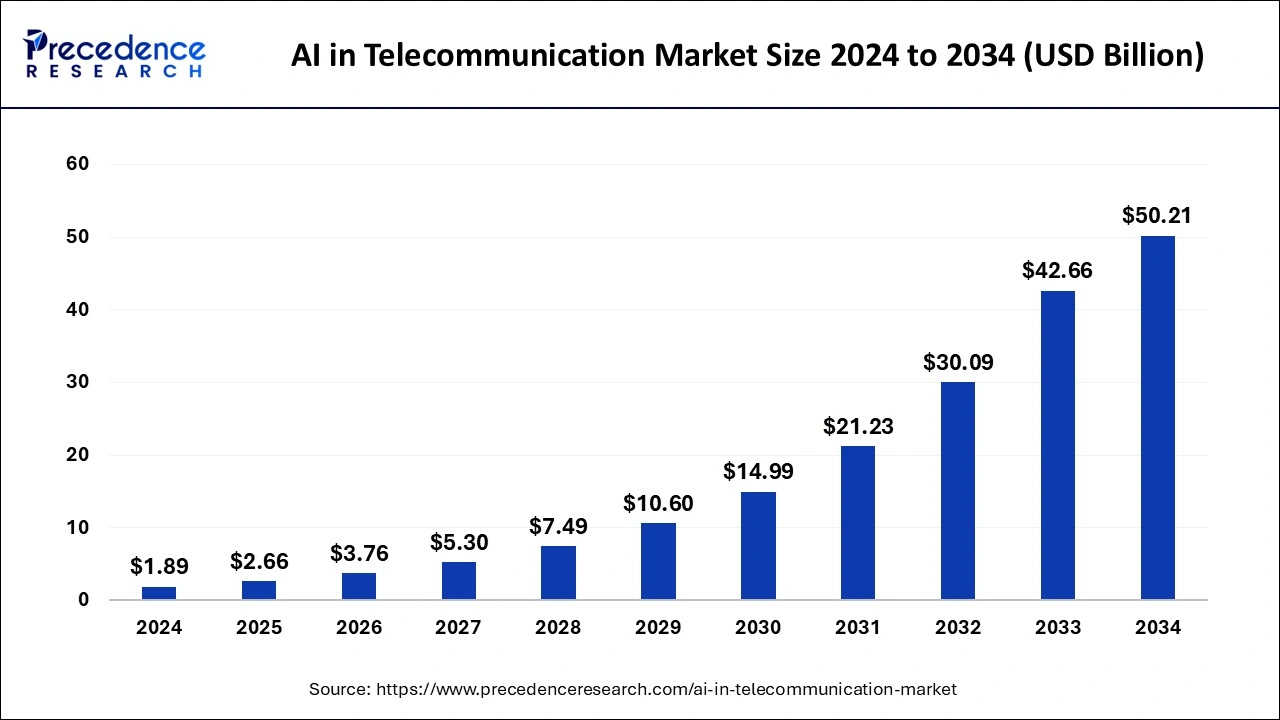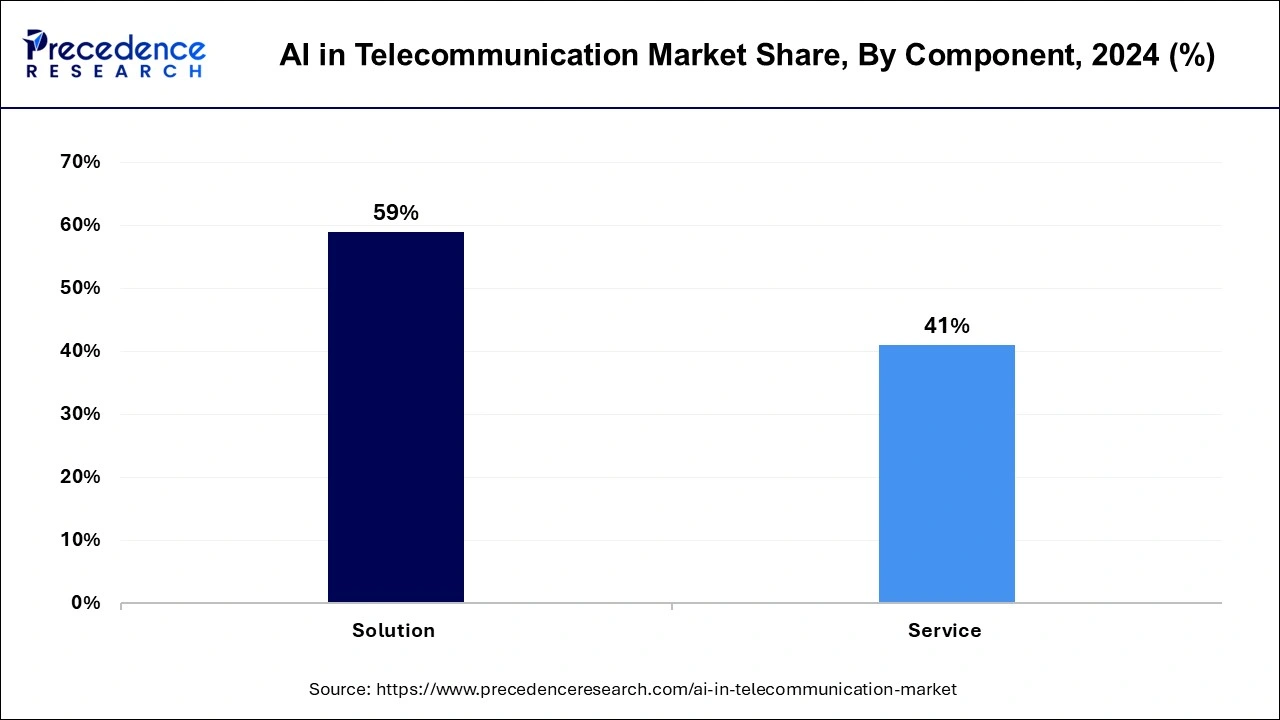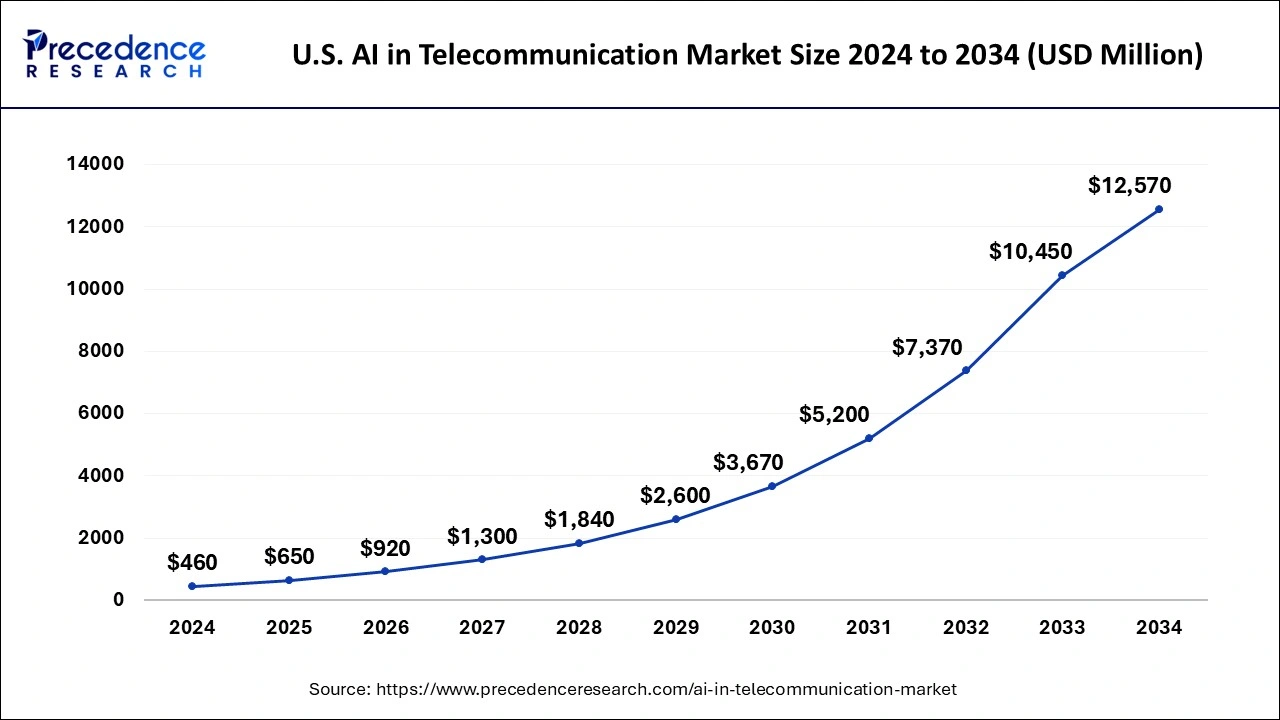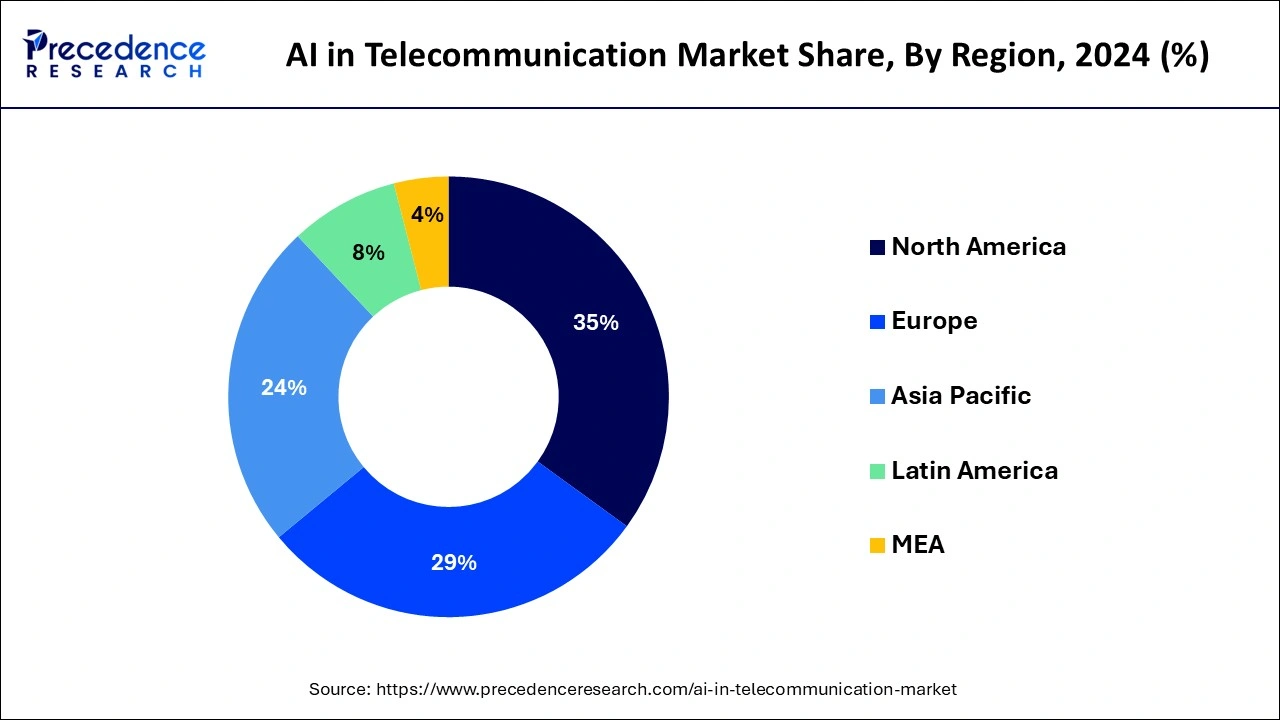List of Contents
What is the AI in Telecommunication Market Size?
The global AI in telecommunication market size is calculated at USD 2.66 billion in 2025 and is predicted to increase from USD 3.76 billion in 2026 to approximately USD 50.21 billion by 2034, growing at a CAGR of 38.81% from 2025 to 2034. The global AI in telecommunication market is driven by the rapid expansion of telecom companies worldwide. Moreover, the growing focus on enhancing customer experience and reducing operational costs further contributes to market expansion.

AI in Telecommunication Market Key Takeaways
- The global AI in telecommunication market was valued at USD 1.89 billion in 2024.
- It is projected to reach USD 50.21 billion by 2034.
- The AI in telecommunication market is expected to grow at a CAGR of 38.81% from 2025 to 2034.
- North America contributed more than 35% of market share in 2024.
- Asia-Pacific is estimated to expand the fastest CAGR between 2025 and 2034.
- By component, the solution segment has held the largest market share of 59% in 2024.
- By component, the service segment is anticipated to grow at a remarkable CAGR of 44.9% between 2025 and 2034.
- By application, the customer analytics segment generated over 29% of market share in 2024.
- By application, the virtual assistance segment is expected to expand at the fastest CAGR over the projected period.
- By technology, the data analytics segment generated over 32% of market share in 2024.
- By technology, the machine learning segment is expected to expand at the fastest CAGR over the projected period.
AI in Telecommunication Market Overview: Redefining the Future
AI is transforming the telecommunication industry by boosting network efficiency, streamlining operations, and elevating customer experiences. Advanced algorithms analyze extensive data sets, predicting and preventing network failures for proactive maintenance and reduced downtime. Predictive analytics powered by AI optimize bandwidth allocation, ensuring resource efficiency and enhanced network performance. In customer service, AI-driven virtual assistants enhance communication with instant responses and personalized interactions.
Additionally, AI simplifies the implementation of 5G networks by automating intricate tasks such as network slicing and dynamic resource allocation. These advancements position AI as a key player in reshaping telecommunication into a more responsive, reliable, and user-friendly ecosystem, ushering in the next era of communication technologies.
AI in Telecommunication Market Growth Factors
- Network Optimization: AI helps telecom companies optimize their networks by analyzing huge amounts of data, such as traffic patterns. This improves performance and reduces operational costs.
- Predictive Maintenance: AI has the ability to predict equipment failures and optimize bandwidth allocation. This, in turn, reduces downtime and enhances overall network efficiency.
- Improved Customer Experience: AI-driven applications such as chatbots and virtual assistants improve customer service by providing instant responses, personalized interactions, and efficient query handling. Enhanced customer experiences contribute to customer retention and loyalty.
- Automation and Cost Savings: AI automates complex telecom processes such as capacity planning and network management, leading to cost savings, faster decision-making, and increased operational efficiency.
- Fraud Detection: AI can identify anomalies in the network, helping telecom companies detect and prevent fraud in real time.
- 5G Integration: AI assists in seamlessly integrating 5G networks by helping in network slicing and resource management processes. It also helps address the complexities associated with 5G infrastructure.
- Cost Reduction: AI automates routine tasks and eliminates human errors, helping telecom companies allocate resources more effectively. This, in turn, reduces operational costs.
AI in Telecommunication Market Outlook: Connecting the Future
- Industry Growth Overview: The growing adoption of 5G technology and increasing demand for enhanced network efficiency, improved customer experiences, and optimized operations are contributing to the industrial growth of the market.
- Sustainability Trends: The sustainability trend focuses on the use of AI to optimize network energy consumption and operations for net-zero carbon emission targets and balanced profitability to environmental responsibilities.
- Global Expansion: The need for improved network performance, reliability, operational efficiency, personalized customer experiences, and reduced cost is leading to the global expansion of the market.
- Major Investors: Corporate giants and prominent venture capital firms are the major investors in the market.
Startup Ecosystem: The development of specialized, scalable AI solutions for specific industry challenges is the focus of the startup ecosystem.
Market Scope
| Report Coverage | Details |
| Growth Rate from 2025 to 2034 | CAGR of 38.81% |
| Market Size in 2025 | USD 2.66 Billion |
| Market Size in 2026 | USD 3.76 Billion |
| Market Size by 2034 | USD 50.21 Billion |
| Base Year | 2024 |
| Forecast Period | 2025 to 2034 |
| Segments Covered | By Component, By Application, and By Technology |
| Regions Covered | North America, Europe, Asia-Pacific, Latin America, and Middle East & Africa |
Market Dynamics
Driver
Network optimization impact
- According to industry reports, AI-driven network optimization has led to an approximate 30% reduction in downtime, ensuring more reliable and stable network performance.
The surge in market demand for AI in telecommunication is significantly driven by the impactful role of network optimization. As telecommunication networks continue to evolve, the demand for enhanced efficiency and performance becomes paramount. AI's ability to optimize networks by predicting and preventing failures, ensuring optimal resource allocation, and reducing downtime has garnered substantial attention.
Reports indicate that telecom companies incorporating AI-driven network optimization experience a remarkable surge in customer satisfaction, with a notable decrease in downtime by approximately 30%. This tangible improvement in network reliability and performance not only enhances the overall user experience but also positions AI as a crucial tool for telecom operators aiming to stay competitive in the dynamic market landscape.
Furthermore, the market demand is propelled by the cost-saving implications of network optimization through AI. Telecom companies adopting AI-driven network optimization solutions report a significant reduction in operational costs, with streamlined processes and efficient resource allocation. This cost-effectiveness not only improves the bottom line for telecom operators but also makes AI in telecommunications an attractive investment, fostering a growing demand for innovative solutions that optimize network infrastructure.
Restraint
Interoperability issues
Interoperability issues stand as a significant restraint to the market demand for AI in the telecommunication sector. The integration of AI solutions into existing telecommunication infrastructure often encounters challenges in ensuring seamless compatibility. Telecommunication networks typically consist of diverse technologies, protocols, and legacy systems, making it complex to integrate AI seamlessly.
This interoperability challenge can lead to disruptions, increased implementation times, and additional costs for telecom operators. As the demand for AI in Telecommunication grows, the inability to address interoperability issues hampers the industry's ability to fully leverage the potential benefits of AI technologies. Telecom companies may hesitate to adopt AI solutions if they perceive potential disruptions to their existing operations. Overcoming these interoperability challenges requires collaborative efforts between technology providers, standardization bodies, and telecom operators to develop solutions that seamlessly integrate AI into diverse telecommunication ecosystems, ensuring a smoother transition and fostering greater market demand for AI in the Telecommunication sector.
Opportunity
Financial services enhancement
- Telecom operators leveraging AI for 5G deployment have experienced a 20% increase in network slicing efficiency and a 15% improvement in dynamic resource allocation.
The successful integration of 5G networks presents significant opportunities for AI in the telecommunication market. 5G's high-speed, low-latency capabilities create a fertile ground for AI applications to thrive. AI can play a pivotal role in optimizing and managing 5G networks, ensuring efficient resource allocation, dynamic network slicing, and handling the complexities associated with the next generation of connectivity.
The demand for AI-driven solutions in 5G integration is driven by the need for real-time analytics, predictive maintenance, and enhanced network performance. Telecom operators can leverage AI to capitalize on the full potential of 5G, offering innovative services and meeting the evolving demands of users. The symbiotic relationship between 5G and AI opens avenues for transformative applications, from smart cities and IoT to augmented reality, creating a dynamic landscape where the success of 5G integration becomes a catalyst for the continued growth and evolution of the AI in Telecommunication market.
Component Insights
The solution segment had the highest market share of 59% in 2024. In the AI in telecommunication market, the solution segment encompasses a suite of AI-driven technologies designed to address specific challenges within the telecommunication industry. These solutions typically include predictive analytics, network optimization tools, virtual assistants, and automation platforms. Trends in this segment indicate a growing emphasis on solutions that enhance network efficiency, customer experiences, and cyber security. As telecom operators seek comprehensive AI-driven answers to complex operational issues, the solution segment is witnessing a surge in innovation to meet the evolving demands of the industry.

The service segment is anticipated to witness rapid growth at a significant CAGR of 44.9% during the projected period. In the AI in telecommunication market, the service segment encompasses offerings that support the deployment, integration, and maintenance of AI solutions. These services include consulting, system integration, training, and support services. As telecom operators increasingly adopt AI technologies, there is a growing trend towards specialized AI service providers offering tailored solutions to meet the unique requirements of the telecommunication industry. The demand for expert services reflects the need for seamless integration of AI into existing infrastructures, ensuring optimal functionality, and maximizing the benefits of AI-driven innovations.
Application Insights
The customer analytics segment has held a 29% market share in 2024. In the AI in telecommunication market, the customer analytics segment involves leveraging artificial intelligence to analyze customer data comprehensively. This includes patterns, preferences, and behaviors, enabling telecom operators to enhance customer experiences, personalize services, and optimize marketing strategies.
The trend in customer analytics within AI for telecommunication is marked by a shift towards predictive analytics, sentiment analysis, and real-time insights. Telecom companies increasingly rely on AI-driven customer analytics to anticipate customer needs, reduce churn, and deliver tailored services, thereby improving overall customer satisfaction and loyalty.
The virtual assistance segment is anticipated to witness rapid growth over the projected period. In the AI in telecommunication market, the virtual assistance segment involves employing AI-driven virtual assistants to enhance customer interactions and support services. These smart virtual agents respond to user queries in real-time, elevating overall customer experience.
A current trend in this sector is the growing incorporation of natural language processing (NLP) and machine learning algorithms. This integration enables virtual assistants to better understand and respond to user queries, streamlining customer support processes. The result is improved efficiency, reduced response times, and an overall enhanced communication experience within the telecommunication industry.
Technology Insights
The data analytics segment has held a 32% market share in 2024. Within the AI in telecommunication market, the data analytics segment centers on using advanced analytics to extract valuable insights from extensive telecom data. This involves employing machine learning algorithms and statistical models to analyze network performance, customer behavior, and operational data. Trends in this sector include the growing embrace of predictive analytics for proactive network maintenance, real-time analysis to enhance decision-making, and the incorporation of AI-powered analytics to boost overall efficiency and elevate customer experiences in the telecommunications industry.
The machine learning segment is anticipated to witness rapid growth over the projected period. The machine learning segment in the AI in telecommunication market involves the application of algorithms that enable systems to learn from data and improve their performance over time. In telecommunication, machine learning is employed for network optimization, predictive maintenance, and customer service enhancement.
Recent trends indicate a growing reliance on machine learning for real-time analytics, anomaly detection, and automation of complex tasks. As telecom operators seek to improve operational efficiency and customer experiences, the machine learning segment continues to be a pivotal technology driving innovation in the AI in telecommunication market.
Regional Insights
U.S. AI in Telecommunication Market Size and Growth 2025 to 2034
The U.S. AI in telecommunication market size is valued at USD 650 million in 2025 and is expected to reach around USD 12,570 million by 2034, growing at a CAGR of 39.21% from 2025 to 2034.

Smart Infrastructure Powers North America
North America held a share of 35% in the AI in telecommunication market due to robust technological infrastructure, widespread adoption of advanced technologies, and a thriving telecommunications sector. The region's early and extensive deployment of 5G networks has spurred the integration of AI for network optimization and customer service enhancement. Additionally, the presence of key market players, substantial research and development activities, and favorable regulatory support contribute to North America's dominance. This region remains at the forefront of AI in telecommunication, driving innovation and shaping the industry's growth trajectory.

Digital Acceleration Transforms Asia Pacific
Asia-Pacific is poised for accelerated growth in the AI in telecommunication market due to a confluence of factors. With a large and rapidly expanding population, increased smartphone penetration, and significant investments in5G infrastructure, the region offers immense opportunities for AI integration in telecommunications. Governments and businesses are actively embracing AI technologies to enhance network efficiency, provide innovative services, and meet the escalating demand for advanced communication solutions. This favorable environment positions the Asia-Pacific region as a key driver for the robust expansion of AI in telecommunication market.
Smart Regulations Drive the Europe Growth
Meanwhile, Europe is witnessing substantial growth in the AI in telecommunication market, driven by proactive measures, heightened investments, and a dedicated focus on digital evolution. Governments and businesses in the region are strategically implementing AI to improve telecommunication network efficiency, elevate customer experiences, and streamline operational processes. The participation of major industry players, favorable regulatory environments, and a technologically engaged consumer base contribute to the swift integration of AI technologies. This expansion reflects a collective commitment to staying competitive globally in the telecommunications arena and harnessing the transformative power of artificial intelligence.
AI Giants Lead the U.S.
The presence of robust AI companies and technological infrastructures in the U.S. is driving advancements in telecommunications. Additionally, the growing R&D investments and adoption of 5G networks are also increasing their use, leading to new partnerships among the companies.
Digitalization Fuels India's Telecom
The growing digitalization in India is increasing the use of AI in telecom, where the growing government initiatives are also providing their support. The growing 5G networks are driving the industries to utilize AI for their optimization. Moreover, the growing R&D is also leading to innovations, where the investments are enhancing their affordability.
UK Powered by 5G and AI
The UK is driven by growing 5G adoption, where the presence of advanced telecom infrastructure is increasing the use of AI for its maintenance, automation, and to enhance customer experience. The companies and universities of the UK are also utilizing AI in telecommunications to enhance cybersecurity, in compliance with regulatory standards.
Broadband Expansion Propels South America
South America is expected to grow significantly in AI in the telecommunication market during the forecast period, due to broadband expansion. This is increasing the use of AI to improve the network efficiency, customer service. They are also being used for network monitoring and maintenance, where the expanding industries are utilizing AI for automation and network analytics.
Argentina's AI Telecom Surge
Argentina's AI in telecommunication market is experiencing rapid growth, driven by investments in 5G infrastructure and increased demand for personalized services [1]. This expansion focuses on enhancing network efficiency and improving customer experience through innovative AI solutions.
The AI in Telecommunication Market Innovators: Key Players' Offering
- Amdocs: The company provides Amdocs amAlz suite, amAlz Agents, Amdocs AI & data platforms, Amdocs customer experience insights, and AI-driven networking solutions.
- Bharti Airtel: Self-optimizing networks are provided by the company.
- PowerX: The company provides PowerX SaaS platforms for various applications.
- Vodafone Ltd.: Products like TOBi, scam signal API, and AI booster platform are provided by the company.
- AT&T Intellectual Property: The company offers AI-driven network intelligence tools and sentiment analysis tools.
- NVIDIA: Solutions such as AI-based network acceleration chipsets and NVIDIA reference architectures are offered by the company.
AI in Telecommunication Market Companies
- Amazon Web Services (AWS)
- SK Telecom
- American Tower Corporation
- Actifai
- CSG
- Nokia
- Genpact
- Actifai
Recent Developments
- In November 2024, ZTE Corporation, a leading provider of communication technology solutions, partnered with China Mobile and launched an AI-driven Green Telco Cloud solution with diverse hardware architectures. This solution helps to enhance energy efficiency in telco cloud environments.
- In January 2024, the GSMA and IBM entered into a collaboration to support the adoption and skills of generative artificial intelligence (AI) in the telecom industry through the launch of GSMA Advance's AI Training program and the GSMA Foundry Generative AI program.
Segments Covered in the Report
By Component
- Solution
- Service
By Application
- Network Security
- Network Optimization
- Customer Analytics
- Virtual Assistance
- Self-Diagnostics
- Others
By Technology
- Machine Learning
- Natural Language Processing (NLP)
- Data Analytics
- Others
By Geography
- North America
- Europe
- Asia-Pacific
- Latin America
- Middle East and Africa
For inquiries regarding discounts, bulk purchases, or customization requests, please contact us at sales@precedenceresearch.com
Frequently Asked Questions
Ask For Sample
No cookie-cutter, only authentic analysis – take the 1st step to become a Precedence Research client